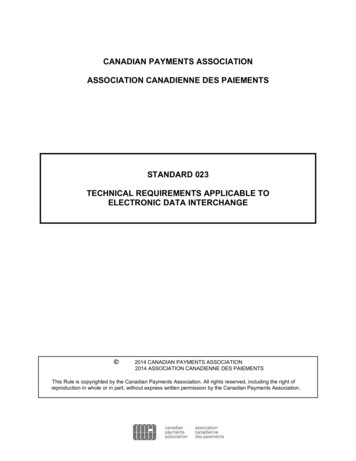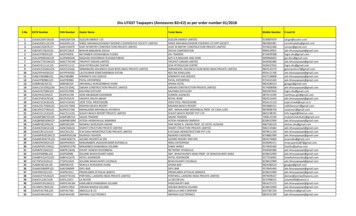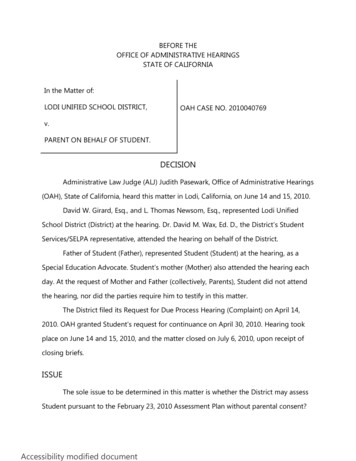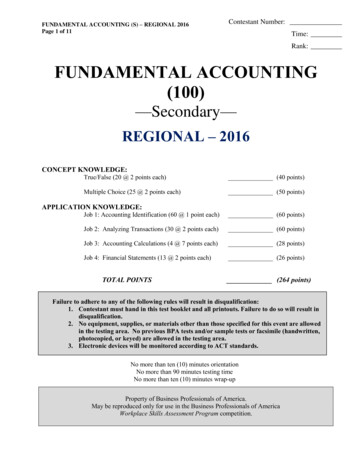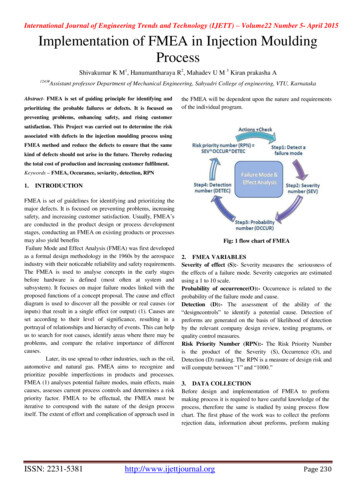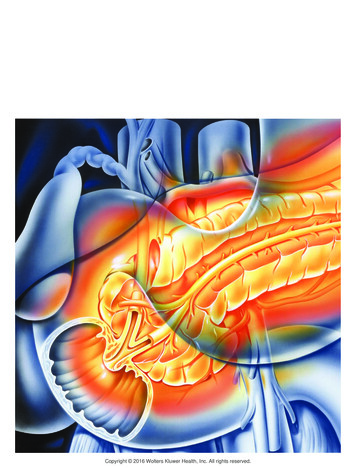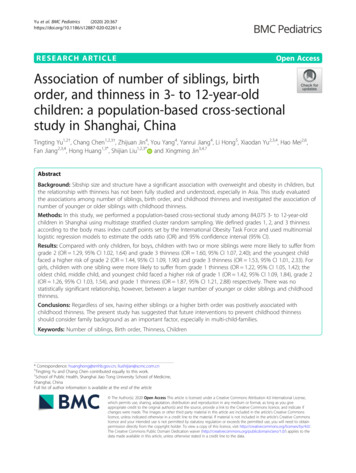
Transcription
Yu et al. BMC Pediatrics(2020) SEARCH ARTICLEOpen AccessAssociation of number of siblings, birthorder, and thinness in 3- to 12-year-oldchildren: a population-based cross-sectionalstudy in Shanghai, ChinaTingting Yu1,2†, Chang Chen1,2,3†, Zhijuan Jin4, You Yang4, Yanrui Jiang4, Li Hong5, Xiaodan Yu2,3,4, Hao Mei2,6,Fan Jiang2,3,4, Hong Huang1,3*, Shijian Liu1,2,3* and Xingming Jin3,4,7AbstractBackground: Sibship size and structure have a significant association with overweight and obesity in children, butthe relationship with thinness has not been fully studied and understood, especially in Asia. This study evaluatedthe associations among number of siblings, birth order, and childhood thinness and investigated the association ofnumber of younger or older siblings with childhood thinness.Methods: In this study, we performed a population-based cross-sectional study among 84,075 3- to 12-year-oldchildren in Shanghai using multistage stratified cluster random sampling. We defined grades 1, 2, and 3 thinnessaccording to the body mass index cutoff points set by the International Obesity Task Force and used multinomiallogistic regression models to estimate the odds ratio (OR) and 95% confidence interval (95% CI).Results: Compared with only children, for boys, children with two or more siblings were more likely to suffer fromgrade 2 (OR 1.29, 95% CI 1.02, 1.64) and grade 3 thinness (OR 1.60, 95% CI 1.07, 2.40); and the youngest childfaced a higher risk of grade 2 (OR 1.44, 95% CI 1.09, 1.90) and grade 3 thinness (OR 1.53, 95% CI 1.01, 2.33). Forgirls, children with one sibling were more likely to suffer from grade 1 thinness (OR 1.22, 95% CI 1.05, 1.42); theoldest child, middle child, and youngest child faced a higher risk of grade 1 (OR 1.42, 95% CI 1.09, 1.84), grade 2(OR 1.26, 95% CI 1.03, 1.54), and grade 1 thinness (OR 1.87, 95% CI 1.21, 2.88) respectively. There was nostatistically significant relationship, however, between a larger number of younger or older siblings and childhoodthinness.Conclusions: Regardless of sex, having either siblings or a higher birth order was positively associated withchildhood thinness. The present study has suggested that future interventions to prevent childhood thinnessshould consider family background as an important factor, especially in multi-child-families.Keywords: Number of siblings, Birth order, Thinness, Children* Correspondence: huanghong@smhb.gov.cn; liushijian@scmc.com.cn†Tingting Yu and Chang Chen contributed equally to this work.1School of Public Health, Shanghai Jiao Tong University School of Medicine,Shanghai, ChinaFull list of author information is available at the end of the article The Author(s). 2020 Open Access This article is licensed under a Creative Commons Attribution 4.0 International License,which permits use, sharing, adaptation, distribution and reproduction in any medium or format, as long as you giveappropriate credit to the original author(s) and the source, provide a link to the Creative Commons licence, and indicate ifchanges were made. The images or other third party material in this article are included in the article's Creative Commonslicence, unless indicated otherwise in a credit line to the material. If material is not included in the article's Creative Commonslicence and your intended use is not permitted by statutory regulation or exceeds the permitted use, you will need to obtainpermission directly from the copyright holder. To view a copy of this licence, visit http://creativecommons.org/licenses/by/4.0/.The Creative Commons Public Domain Dedication waiver ) applies to thedata made available in this article, unless otherwise stated in a credit line to the data.
Yu et al. BMC Pediatrics(2020) 20:367BackgroundPreschool- and school-age years are critical periods for achild’s growth and development. During these stages, children experience rapid but incomplete physical and psychological development, causing them to be the mostvulnerable group in the population. Thus, children requiremore attention and support from family and society [1, 2].With the rapid development of the economy and the advancement of urbanization, the double burden of obesityand thinness has become increasingly prominent in manydeveloping countries [3–5]. Although the prevalence ofoverweight and obesity has received considerable attentionin China, many researchers have shown that childhoodthinness is also an important public health problem thatcannot be ignored. In 2010, China had a thinness rate of9.0% among children ages 6 to 17 years old, including10.4% for boys and 7.3% for girls [6]. In Shanghai, theprevalence of thinness was 13.92% for boys and 18.45% forgirls ages 3 to 12 years old [7].Thinness is an indicator of recent undernutrition and eating disorders and often is associated with physical, mental,and intellectual development problems, as well as a higherrisk of metabolic disease in adulthood [8–10]. Families playa vital role in the intervention of children with undernutrition, and studies have reported that family structure affectschildhood physical development [11–13]. In one-child families, parents and grandparents pay all their attention totheir single child or grandchild. Excessive doting by familymembers has resulted in childhood overweight and obesity[14]. In multi-child-families, however, with an increase inthe number of siblings, parents’ time, energy, and financialresources are diluted among their children [15]. Studieshave found that sibship composition is significantly associated with childhood obesity or undernutrition (thinness,stunting, or underweight) [13, 16–22]. Most studies havesupported the finding that children who have siblings andolder children have a lower risk of being overweight orobese [13, 16–19]. Results illustrating the associations ofthe number of siblings and birth order with undernutritionwere inconsistent, however. Some studies found that achild’s risk of undernutrition was higher as the birth orderor number of siblings increased [20–22]. A previous studyreported that a larger number of siblings increased the oddsratio for thinness for girls but not for boys [23]. By contrast,one study showed no relationship between the number ofsiblings or birth order and thinness [24].To change the demographic structure, China has introduced several family-planning policies, including theone-child policy, which was introduced nationwide in1980 (except for ethnic minorities and rural familieswhere the first child was a girl) but that was influencedby region, parental educational level, family economiclevel, and other factors during its implementationperiod; and the two-child policy, which was adopted forPage 2 of 13families with one parent as the only child in 2013 andthen implemented nationwide in 2016 [25]. China became the country with the largest population of onlychildren in the world (about 100 million) as a result ofthis one-child policy [26]. However, with the implementation of China’s two-child policy, family structure andpersonal relationships, especially sibling structure andrelationships, became increasingly complicated and havehad an unpredictable effect on childhood health. Therefore, after excluding the influence of early life nutrition,childhood living habits, and family economic level,which all were related to sibship composition and childhood thinness, this study evaluated the influence of sibship size and structure on childhood thinness anddiscerned whether sex interaction existed between them.MethodsStudy design and participantsThis investigation was based on a large school-based crosssectional study that was part of a population survey of autismspectrum disorders led by the government. Relevant sampling methods have been described in a previous study [7]and are briefly stated as follows. This study was conductedusing multistage, stratified cluster random sampling amongchildren ages 3 to 12 years old in Shanghai, China, in June2014. We randomly selected three urban districts and foursuburban districts from a total of 17 districts across Shanghai. In total, 134 of 949 (14.12%) kindergarten schools, aswell as 70 of 436 (16.06%) primary schools, were randomlysampled from a set of schools located in the selected districts(Fig. 1). In total, 84,075 of 576,621 (14.58%) children were recruited from these selected schools according to the proportion of students in each district to all of the sampled districts.The child’s family, social environment, and growthquestionnaires were administered to teachers, who accepted uniform training on completing, distributing, andcollecting the questionnaires. Teachers informed theirstudents to take the questionnaire home, and then thestudents’ parents were asked to complete the questionnaire to collect multilevel information on the child’scharacteristics (e.g., age, sex, weight, height, number ofsiblings, birth order, birthweight, feeding pattern, parental ages at childbirth, workday TV time, Internet usetime, and snacking frequency) and family structure (e.g.,parental weight status, parental education level, familyincome and residential site). Then, the teachers collectedthe completed questionnaires and returned them to theinvestigators. Questionnaires with key information missing, including height, weight, number of siblings, or birthorder, were excluded in the final analysis.MeasurementBody mass index (BMI, kg/m2) was calculated as weight (kg)divided by height (m) squared. Thinness, overweight, and
Yu et al. BMC Pediatrics(2020) 20:367Page 3 of 13Fig. 1 Study flowchart using multistage and stratified cluster random samplingobesity were defined according to the International ObesityTask Force–recommended age- and sex-specific cutoff pointsfor children ages 2 to 18 years old. The BMI cutoffs for grades1, 2, and 3 were 18.5, 17.0, and 16.0 kg/m2, respectively,and the cutoff for overweight was 25.0 kg/m2. The cutoff forobesity was 30.0 kg/m2, and the cutoff for severe obesity was 35.0 kg/m2 [27, 28]. For adults, the weight status was categorized by BMI into underweight ( 18.5 kg/m2), normal weight(18.5–25.0 kg/m2), and overweight ( 25.0 kg/m2) classes,which included obesity and severe obesity as defined based onthe World Health Organization cutoffs.According to a previous study [17], we divided thenumber of siblings into three groups as follows: none(only child), one, and two or more siblings. We categorized birth order into four groups as follows: only child,oldest child, youngest child, and middle child. We included the number of younger or older siblings in threegroups: none (only child), one, and two or more siblings.For birth order, the middle child represented childrenwho had younger sibling(s) and older sibling(s). For thenumber of younger siblings, the one-sibling group or thetwo-or-more-siblings group represented the childrenwho were the oldest child and who had either one ortwo or more younger siblings. For the number of oldersiblings, one or two or more siblings represented children who were the youngest child and who had eitherone or two or more older siblings.Childhood characteristics included age (in years), sex(boy, girl), birthweight ( 2500, 2500–4000, or 4000 g),feeding pattern (breast-feeding, formulary-feeding, mixedfeeding), parental ages at childbirth ( 25, 25–34, or 35years old), workday TV time ( 1, 1–3, or 3 h/day), Internet use time ( 2, 2–4, or 4 h/day), and snacking frequency (0, 1–3, or 3 times/day) were considered aspotential prenatal confounding factors [22, 24, 29]. Familycharacteristics included parental education level,which was divided into low (illiterate, primary school,or junior high school), middle (senior high school,technical school, or college), and high (undergraduateor above). Family income was categorized into threegroups as follows: low ( 10,000, 10,000–30,000, or30,000–50,000 Chinese yuan), middle (50,000–100,000, 100,000–150,000, or 150,000–200,000 Chineseyuan), and high (200,000–300,000, 300,000–1,000,000,and 1,000,000 Chinese yuan), according to a socialscience definition [30]. Residential site was defined asurban or suburban residents according to the participants’ living district.
Yu et al. BMC Pediatrics(2020) 20:367Page 4 of 13Statistical analysisWe used EpiData 3.1 (EpiData Association, Odense,Denmark) for data entry and applied a logic error check.To ensure the reliability, consistency, and correctness ofinputted data, we randomly sampled 15% of questionnaires for repeat data entry. We obtained verbal consentfrom all participants and their parents before investigation. This study was approved by the Institutional Review Boards of the Shanghai Municipal Commission ofHealth and Family Planning.All statistical analyses were conducted using the software package IBM SPSS Statistics (version 24.0). Wecomputed sampling weights using inverse probabilityweighting, which represented the inverse of the combined selection probability in each sampling stage. Sample weight (Wt Sample) was the product of thesampling weights and the nonresponse weight, whichwas calculated by the following equation:Wt Sample ¼ Wt Strat1 Wt Strat2 Wt NR;ð1Þwhere Wt Strat1 is the inverse probability of an “urbandistrict” or “suburban district” being selected in the centralurban or suburban districts stratum in Shanghai,Wt Strat2 represents the inverse probability of a “kindergarten” or “primary school” being selected in the kindergarten or primary school stratum in each selected district,and Wt NR is the inverse probability of the nonresponserate for questionnaires in each of the selected districts.We used the Chi-square tests to compare the distribution of childhood and family characteristics, as well asprevalence of thinness among the groups for differentnumbers of siblings, birth order, number of younger siblings, and number of older siblings. Combing with LOGISTIC module in complex sampling, which consideredsample weight and sampling method, we used multinomial logistic regression models to calculate the ORand 95% CI of the number of siblings, birth order, number of younger siblings, and number of older siblings forgrades 1, 2, and 3 thinness among boys and girls. Wemade additional adjustments for the multinomial regression models, including model I: adjusted for age, whichwas related to the BMI category; model II: adjusted forage and childhood characteristics, including birthweight,feeding pattern, parental age at childbirth, workday TVtime, Internet use time, and snacking frequency, whichwere reported to be associated with sibship compositionand BMI category; and model III: adjusted for age, childhood characteristics, and family characteristics, includingparental weight status, parental education level, familyincome, and residential site, which could reflect the family resources for children to some degree. The statisticalsignificance was defined as a P-value 0.05 by a twotailed test.ResultsA total of 84,075 questionnaires were distributed to participants ages 3 to 12 years old, and 81,384 completedquestionnaires were collected with a response rate of96.80%. In total, 13,810 children (16.97%) were excluded,among which 8949 (11.00%) had incomplete height orweight data, and 4861 (5.97%) had no data on number ofsiblings and birth order. We included 67,574 children inour final analysis, including 35,835 boys (53.03%) and31,739 girls (46.97%).Table 1 shows the characteristics of study participantsarranged by the number of siblings. Overall, the numberof children with no siblings (only child), one sibling, andtwo or more siblings were 49,097 (72.66%), 6852(10.14%), and 11,625 (17.20%), respectively. The averageage (mean SD, standard deviations) of only children,those with one sibling, and those with two or more siblings was 7.03 2.30, 6.99 2.25, and 7.41 2.19 years,respectively (not shown in the table). The proportion ofboys in each number of sibling groups was higher thanthat of girls, especially in the one-child category (p 0.001). Low birthweight (p 0.029) and breast-feeding(p 0.001) and mothers (p 0.001) or fathers (p 0.001)aged at childbirth younger than 25 years old were morecommon in the two-or-more-siblings group. WorkdayTV time (p 0.001), Internet use time (p 0.001), andsnacking frequency (p 0.001) were statistically differentin the groups with different numbers of siblings.Family characteristics according to the number of siblings are shown in Table 2. In the only-child group,more children had fathers (p 0.001) and mothers (p 0.001) who were underweight and more children werefrom urban residential families (p 0.001). Most of theonly children had a highly educated father (p 0.001) ormother (p 0.001) and had higher family income (p 0.001) than that of the children with siblings.We calculated the prevalence of thinness in relation tothe number of siblings, birth order, and number ofyounger or older siblings (the distribution is shown inTable 3). In general, the prevalence of thinness of onlychildren (14.96%) was lower than that of children withsiblings (one sibling: 18.18%; two or more siblings:17.45%). In the only-, oldest-, middle-, and youngestchild groups, the prevalence of thinness increased asbirth order increased (14.96, 17.73, 17.11, and 19.51%,respectively). In the groups with different numbers ofyounger or older siblings, thinness was more common inthe oldest child with two or more younger siblings(18.31%) or in the youngest child with one older sibling(17.53%).
Yu et al. BMC Pediatrics(2020) 20:367Page 5 of 13Table 1 Characteristics of study participants by the number of siblingsVariablesNone (only child)OneNN%%Two or 0067,574100.00Birth weight (g) 484.70553280.74871274.9455,82882.62 011,625100.0067,574100.00Feeding patternsBreast mulary Feeding795716.21105415.38167414.4010,68515.81Mixed 52100.0011,625100.0067,574100.00Workday TV time (hour/day) 5337.38284341.49553447.6026,73039.56 00.0067,574100.00Internet use time (hour/week) 3522.88134619.64174214.9814,32321.20 11,625100.0067,574100.00Snack frequency 891–330,64362.41435563.56772466.4442,72263.22 00.0067,574100.00Father’s age at child birth (years) 80068.84407859.52626453.8844,14265.32 0.0011,625100.0067,574100.00Mother’s age at child birth (years) 0,88262.90398558.16593351.0440,80060.3832.94 0.0014.770.0298475.14 0.00141,614.76 0.00133,821.76 0.00137,680.69 0.001976.81 0.0011518.61 0.001
Yu et al. BMC Pediatrics(2020) 20:367Page 6 of 13Table 1 Characteristics of study participants by the number of siblings (Continued)Variablesaχ2None (only child)OneTwo or moreTotalN%N%N%N% ,625100.0067,574100.00PvalueaP Value from Chi-squared testT
Preschool- and school-age years are critical periods for a child’s growth and development. During these stages, chil-dren experience rapid but incomplete physical and psy-chological development, causing them to be the most vulnerable group in the population. Thus, children require m


